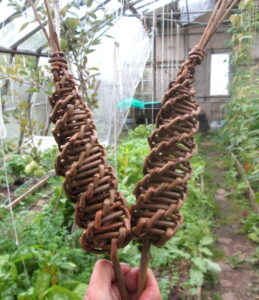 It’s the point in the year when I start eyeing the Autumn crops and wondering if I should begin picking them. I will manage to resist, it’s still August, not really sprout time yet! I would normally leave the bulk of the carrots until mid September but I’ve seen signs of vole activity around them so I’m going to pull up all the carrots over the next two weeks. I’d rather not have my harvesting calendar dictated by small furry creatures but I suppose that’s the nature of organic growing. I have to work with nature even when I feel like nature’s out to get me.
It’s the point in the year when I start eyeing the Autumn crops and wondering if I should begin picking them. I will manage to resist, it’s still August, not really sprout time yet! I would normally leave the bulk of the carrots until mid September but I’ve seen signs of vole activity around them so I’m going to pull up all the carrots over the next two weeks. I’d rather not have my harvesting calendar dictated by small furry creatures but I suppose that’s the nature of organic growing. I have to work with nature even when I feel like nature’s out to get me.
There are eight week’s left in this year’s weekly veg scheme, out of a total of twenty eight. I’ve started sowing follow on crops in the Polycrub and greenhouse for October, it’s much pleasanter picking salad leaves undercover in the Autumn rather than outside in a windy field. Anything sown now undercover can be left over Winter for picking again in the Spring.
I have a stall at a Craft Market in Minginish next week so I’m trying to fit in some willow weaving and felt making. I can do small willow projects when I’m waiting for customer pick ups on Tuesday and Wednesday, actual baskets need a whole afternoon with no interruptions. Felt making needs a big table and makes a mess so not really a good waiting in the caravan activity.
This week’s Croft Shares have the following:
Small – Tomatoes, potatoes, broccoli, carrots and salad leaves.
Medium – Tomatoes, potatoes, purple sprouting broccoli, French beans, peppers, cauliflower or a big green broccoli and carrots.
Large – Tomatoes, potatoes, broccoli, carrots, summer squash/courgettes, salad leaves, spinach, beetroot, mange tout and onions.
There is a little bit of beetroot from outside that escaped the voles. They’re definitely in the baby beetroot category so are sweet enough to eat raw.
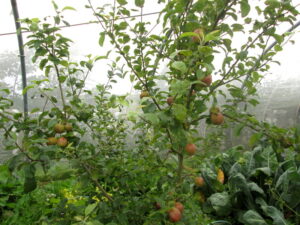 The wind gave the greenhouse a good shake and some emergency repairs were required. The French beans and courgettes all survived though. I’ve some experimental celeriac in the greenhouse which has grown a lot of very impressive leaves but not a lot of root so far. My experiments this year have been a bit hit and miss – the kohl rabi tasted nice but grew so slowly there wasn’t much point to them as a hungry gap crop, the various types of cauliflower have produced some nice green caulis which I will grow again and the pepper crop in the Polycrub is very successful. I think that last one is more to do with the weather than anything I’ve done.
The wind gave the greenhouse a good shake and some emergency repairs were required. The French beans and courgettes all survived though. I’ve some experimental celeriac in the greenhouse which has grown a lot of very impressive leaves but not a lot of root so far. My experiments this year have been a bit hit and miss – the kohl rabi tasted nice but grew so slowly there wasn’t much point to them as a hungry gap crop, the various types of cauliflower have produced some nice green caulis which I will grow again and the pepper crop in the Polycrub is very successful. I think that last one is more to do with the weather than anything I’ve done.
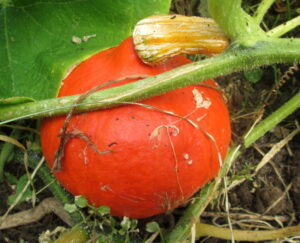
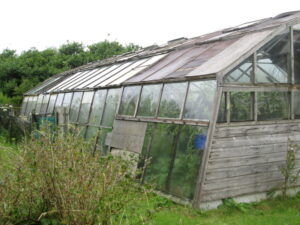
 We spent most of last week weeding and tidying the croft, it is looking very nice, almost park-like in places! The hedges and trees have really grown a lot this year, the wind reduction is really noticeable now. Our plan for next year is taking shape, we’re going to have a smaller, flat raised bed area and two new ploughed areas. The way to turn the back field into big beds for growing in seems to be to plough, add lots of organic matter, grow tatties for two years then try something else, like broccoli or beetroot. Hopefully after that, ploughing won’t be necessary again and we can just keep mulching with the usual mix of compost, old hay, leaves and seaweed. The fashionable growing method at the moment is “no-dig”, this involves spreading manure or compost on the surface, rather than digging it in. This works fine and is easier but we find that in order to get to that point “a bit of dig” is unavoidable. So ploughing’s on the to-do list for the Autumn along with a million other things.
We spent most of last week weeding and tidying the croft, it is looking very nice, almost park-like in places! The hedges and trees have really grown a lot this year, the wind reduction is really noticeable now. Our plan for next year is taking shape, we’re going to have a smaller, flat raised bed area and two new ploughed areas. The way to turn the back field into big beds for growing in seems to be to plough, add lots of organic matter, grow tatties for two years then try something else, like broccoli or beetroot. Hopefully after that, ploughing won’t be necessary again and we can just keep mulching with the usual mix of compost, old hay, leaves and seaweed. The fashionable growing method at the moment is “no-dig”, this involves spreading manure or compost on the surface, rather than digging it in. This works fine and is easier but we find that in order to get to that point “a bit of dig” is unavoidable. So ploughing’s on the to-do list for the Autumn along with a million other things.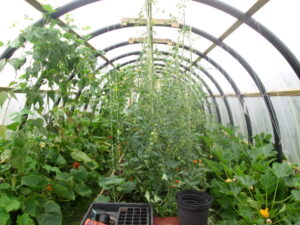 Shockingly I’ve just started sowing the plants for next Spring’s harvest – purple sprouting broccoli, kalettes and cabbage. I’m not too sure where I’ll plant them yet, somewhere away from ravenous voles, so probably in the back field where the aerial predators are.
Shockingly I’ve just started sowing the plants for next Spring’s harvest – purple sprouting broccoli, kalettes and cabbage. I’m not too sure where I’ll plant them yet, somewhere away from ravenous voles, so probably in the back field where the aerial predators are.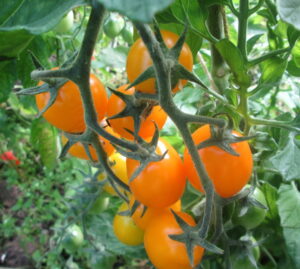
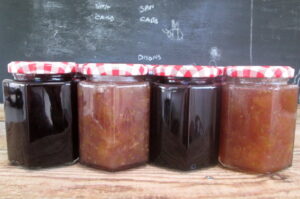 I have the next Armadale Market this weekend so I’ve made some jam – gooseberry or blackcurrant. It is 340g/£5.50. I’ll be making some smaller jars this week – around 225g/£4.00. If any any weekly veg customers would like some I can put a jar aside. I may make some chutney at some point. I’m using my parent’s kitchen so I would need to wait for them to go on holiday before chutney making. I can’t really subject them to hours of strong vinegar smells which take days to clear!
I have the next Armadale Market this weekend so I’ve made some jam – gooseberry or blackcurrant. It is 340g/£5.50. I’ll be making some smaller jars this week – around 225g/£4.00. If any any weekly veg customers would like some I can put a jar aside. I may make some chutney at some point. I’m using my parent’s kitchen so I would need to wait for them to go on holiday before chutney making. I can’t really subject them to hours of strong vinegar smells which take days to clear!